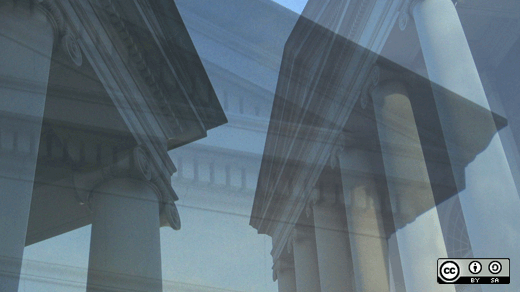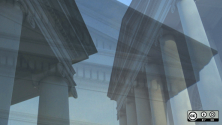On January 23 this year, the Santa Clara High Tech Law Journal had their annual symposium on open source in the legal field at Santa Clara University. Prominent practitioners in the open source community spoke on topics ranging from licensing and compliance to healthcare and entertainment law.
For anyone newly learning about open source licensing, this is a great look at some of the issues today.
This is my account of the symposium.
Open source licensing and business models
Andrew Hall, Hall Law
Andrew started the morning keynote by giving the audience a foundation on open source, providing a practical, business definition of FOSS, and delineating between FOSS licensing and commercial software licensing. He then described some of the more successful FOSS business models, including dual-licensing of proprietary client software, providing commercial or enterprise versions or extensions to FOSS software, providing related services supporting FOSS-licensed software, and closed-source commercial distributions of FOSS modified or combined with proprietary software.
Open source compliance
Ibrahim Haddad, Samsung
Technology companies today have open source components everywhere, making the business environment fairly unpredictable due to non-negotiable open source licenses involving potentially thousands of contributors. Compliance mitigates these risks, and involves observing notices and satisfying license obligations. Since being found non-compliant ultimately requires compliance on top of additional obligations, ensuring compliance from the start is cheaper than non-compliance.
A successful compliance process is demanding, so tools and automation are critical to ensure efficiency. Though the scale of operations means a mistake will be made no matter what protection is established, multiple layers of assurances should still be instituted to increase confidence of results. An emergency plan can be set in place to deal with the inevitable error.
Open industry standards
Lawrence Rosen, Rosenlaw & Einschlag
An open standard requires that it’s publicly available, has various rights-to-use associated with it, and particular properties are defined for how it was designed. If the standard provisions restricts its use—such as its integration into specific products—then the standard is not open source. Licenses for standards by standard organizations, such as the W3C, should be compatible with open source and allow forking.
Building exponential communities
Jono Bacon, XPRIZE Foundation
Communities can be classified as "read" or "write." "Read" communities primarily consume their shared interest, while "write" communities, such as that of open source, contribute to it. An overall, worldwide exponential growth in technology and access means many communities today are exponential communities. As such, audacious goals for these communities can be realistically set and achieved. However, building communities requires strategic planning and foresight of possible pitfalls. Open source innovates with this type of planning, having reached an “early majority” stage, while wider community management is just at the end of the “early adopters” stage.
In an open source business environment, community managers have to communicate effectively with marketing and engineering departments. Plugging the community managers into the technical aspects of the engineering process—such as revision control or patch writing—is beneficial to the whole organization.
Trademarks for open collaboration
Luis Villa and Yana Welinder, Wikimedia
There is an inherent tension in trademark’s insurance of quality through control and open source’s innovation through non-control, as well as traditional assumption of a product’s single source compared to open source collaboration.
One solution to this tension involves using two marks: one mark represents the community, while the other represents the end product, i.e. the quality-controlled distributor Red Hat sponsoring the Fedora community’s trademark.
Creating one collective membership mark to represent the members of a collective, rather than the particular products or services, is a better solution. Another solution involves the decentralized creation of provisions which are permissive and user-friendly. Community participation in trademark policy creation helps anticipate trademark uses to establish permissiveness, where legally safe.
Open source healthcare
David Uhlman, ClearHealth, Inc.
Longstanding institutional problems in healthcare include medical school training lag resulting in technological deficiency of doctors, as well as healthcare spending less than 5% of budgeting on IT. The government recently offered monetary incentives to providers through “meaningful use” to get them to use technology, but most hospitals today are still technologically illiterate, and open source doesn’t mean much to them as a useful concept.
If this can be overcome, open source can provide long-term stability and cost sustainability to hospitals and healthcare compared to commercial vendors.
Managing patent portfolios in an open source landscape
Heather Meeker, O’Melveny & Myers LLP
Patent defendants need to understand open source licensing and these two concepts: unintentional licensing and copyright judo.
Unintentional licensing happens because companies don’t know what open source software their employees are writing, which gets licensed out under an open source terms with an express patent grant in the license.
These lead to copyright judo, where a big company suing you for patent infringement can be successfully counterclaimed against using a non-patent claim, as their size makes it difficult to keep track of their open source involvement.
Open source and entertainment law
John Shaeffer, Lathrop & Gage LLP
Initially it seems that many of the motives that apply in open source communities don’t apply in entertainment. More people writing a movie script doesn’t necessarily make it better, while more programmers inspecting a piece of code does help find bugs and does make the writing process more efficient. But there is a shared commonality in the two arenas: promoting adoption by reducing barriers to access.
FOSS software gains adopters competing against commercial actors by giving away their code, while musicians gain an audience by giving away their music for free, so people can try and “adopt” it.
Open Source
A collection of articles about how to get started in open source.






Comments are closed.